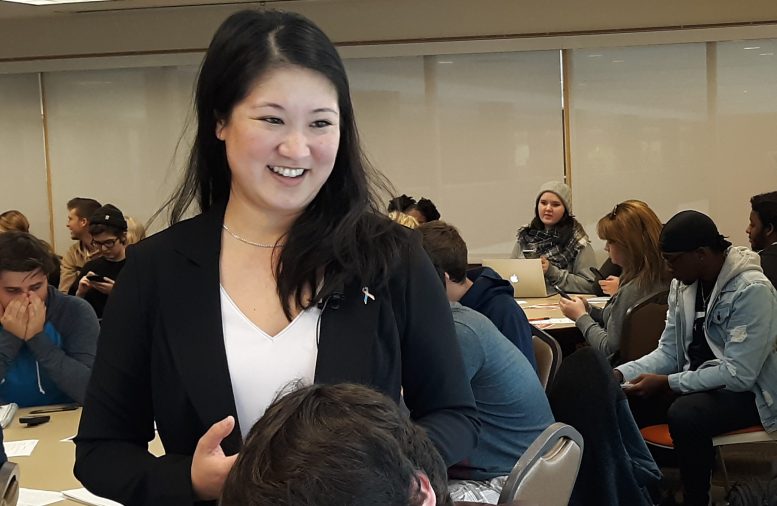By JAN LARSON McLAUGHLIN
BG Independent News
Dr. Lisa Hanasono and her husband were thrilled to see their “baby spud” on the sonogram screen.
“We were elated. We got to hear the heartbeat,” which put their dreaming and planning for their baby into overdrive.
But at 12 weeks along, a second sonogram could find no heartbeat.
“Her face fell,” she said of the medical technician doing the sonogram.
“I am so sorry, we lost the baby,” the technician said.
That day in 2015 changed Hanasono’s life, and led to her interest in “Shattering the Silence on Miscarriage and Pregnancy Loss.”
Hanasono, an associate professor in the School of Media and Communication at BGSU, recently talked about the “M” word during a lecture on campus.
Since the age of 3, Hanasono had two goals in life – to be a teacher and to be a mom.
“I always wanted to have babies in my life,” she said.
When she had the miscarriage, she not only lost the baby, but she also suffered from the silence so many women encounter after pregnancy loss.
“For a while, I coped in silence,” Hanasono said.
At some point she started talking – and found a “secret society” of women grieving by themselves after miscarriage. As a communications professor, the light bulb went off.
“Why aren’t we talking about this,” she said. “Why are miscarriages and pregnancy losses still taboo topics?”
Hanasono went beyond talking and started studying the subject. She discovered a startling statistic. According to the American Pregnancy Association, one in four known pregnancies end in a miscarriage.
Hanasono knew she had to dig deeper.
“Each statistic has a story,” she said. For her research, Hanasono has been collecting those stories for her study, “The M-Word: An Interview Study.”
So far, she has listened to the stories of women aged 17 to 74, who have experienced anywhere from one to five miscarriages. She would like to talk to 40 women for the study.
Hanasono has heard common themes. Many times women blame themselves for the miscarriage. They wonder if they exercised too strenuously. They question if the alcohol they drank before knowing they were pregnant could have caused the loss.
Hanasono remembered those feelings herself. “Most of the time, the women blamed themselves. I felt bad for my partner. I felt like I failed him.”
Often the women get no concrete reasons for the miscarriages, so the shame may be magnified.
“Sometimes there are no answers,” she said. And that makes it difficult to move onto the next pregnancy because of the anxiety they might make the same mistakes.
Couples often wait until about 12 weeks into the pregnancy to tell friends and family that they are expecting. So if a miscarriage occurs, it’s difficult to ask for support for the loss if no one knew about the pregnancy. And hurtful comments about the loss being less significant because it was so early, do not help with the grief, Hanasono said.
Many of the women have a hard time with the cultural taboos of talking about miscarriages. In many cases, the loss of a pregnancy is an “ambiguous loss,” where the parents don’t get to say goodbye, don’t get to have a memorial service, don’t get to visit a gravesite.
And the lack of “cultural scripts” leaves friends and family not knowing what to say.
Media representations of miscarriages don’t help much, Hanasono said. She asked the students in the lecture to give examples of miscarriages handled in the plot lines of shows. The topic was steeped in misrepresentations, such as:
- “Sex in the City,” where Charlotte has a miscarriage then goes to a party at the end of the episode.
- “Grey’s Anatomy,” where Meredith is dealing with a miscarriage while trying to save victims of an active shooter at the hospital.
- “Up,” where the animated couple paint the nursery for their baby, lose the pregnancy, mourn for five seconds, then go on with life.
- “The Help,” where a woman is consumed by fear that repeated miscarriages will cause her husband to leave her.
In some cases, the books intended to help couples plan for their pregnancies aren’t much better than the dramatic depictions.
Hanasono passed out a stack of pregnancy books to the students, asking them to locate the sections on miscarriages. One book had seven pages on the dangers of eating deli meats, and five pages on how to deal with a mother-in-law – but none on handling a miscarriage.
Of the 40-plus books Hanasono has studied, miscarriage is discussed in about 15 pages of the average 356-page guides to pregnancy.
For those texts that do address loss of a pregnancy, the topic really should be dealt with in more human and less clinical language, she said.
Two years after her miscarriage, Hanasono had a healthy baby boy. But she has not forgotten the pain of the loss and the silence surrounding it.
“I’m committed to shattering the silence,” she said.
Hanasono offered suggestions of how the silence could be shattered and how support could be improved after a miscarriage:
- Tackle the taboo. “We need to come together and rethink some better rituals” to help with coping after the loss, such as memorial sites being available for lost babies.
- Create better sick leave policies for those experience miscarriage or pregnancy loss.
- Come up with communicative scripts, “so we are ready to be supportive.”
- Improve media representations about miscarriages in news coverage, celebrity stories, and sharing of stories on social media.
- Create more realistic storylines on TV shows.
- Do more research, so medical professionals can learn better ways to communicate about miscarriages.
- More women should share their own stories. “In order to break the silence, we need multiple voices,” she said.

